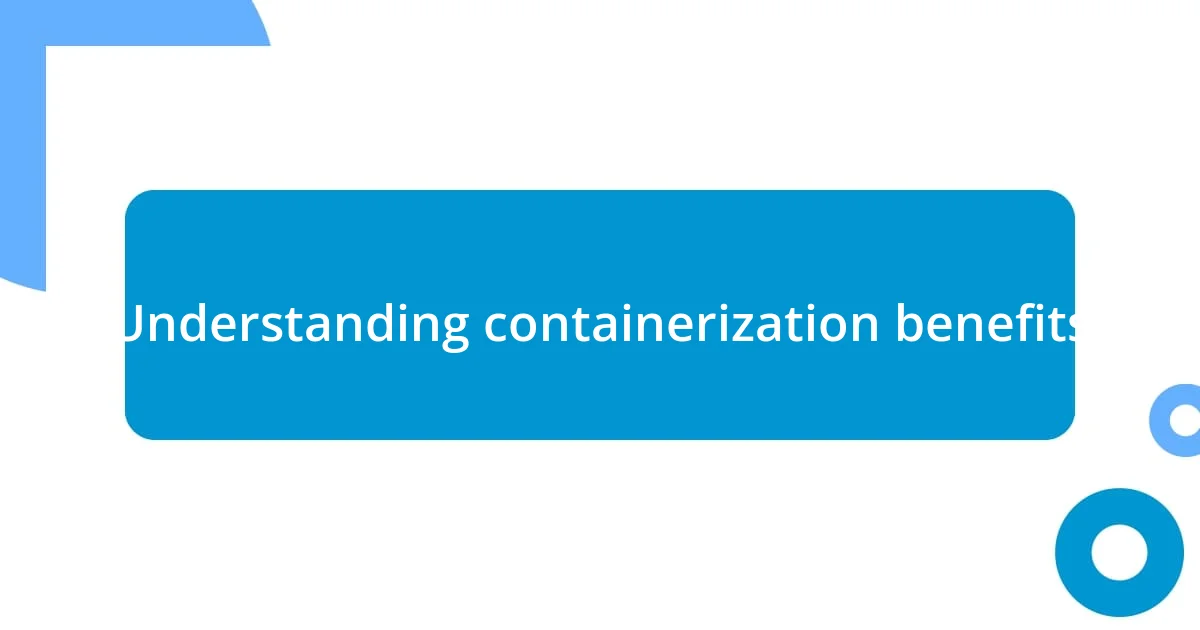Key takeaways:
- Containerization streamlines development, enhances collaboration, and improves resource efficiency, leading to cost savings and increased productivity.
- Choosing between Docker and Kubernetes depends on the project’s needs; Docker is ideal for smaller applications, while Kubernetes excels in managing large, scalable projects.
- Best practices for container management include automating lifecycle events, maintaining proper resource allocation, implementing health checks, and utilizing monitoring tools for performance metrics.

Understanding containerization benefits
One of the most significant benefits of containerization is its ability to streamline the development and deployment process. I remember a project where we needed to scale rapidly; by using containers, we could easily replicate our application across different environments. Isn’t it refreshing when a tool simplifies what would otherwise be a huge headache?
In my experience, containerization also enhances collaboration among team members. I’ve seen how developers and operations can expedite their workflow, as containers eliminate the “it works on my machine” syndrome. Think about it—having a consistent environment across the board not only fosters teamwork but also reduces the time wasted in troubleshooting.
Another aspect that really resonates with me is the resource efficiency containers offer. They utilize fewer system resources compared to traditional virtual machines, which is a game-changer for budget-conscious projects. Reflecting on a previous project where we maximized our infrastructure, the cost savings from using containers allowed us to allocate resources to other crucial areas, ultimately boosting our productivity. Would you agree that finding ways to be both efficient and cost-effective is vital in today’s fast-paced tech environment?

Choosing the right container technology
When it comes to choosing the right container technology, I often find myself weighing the pros and cons of the available options. Docker is a popular choice with a robust community and abundant resources. I recall a project where we needed a straightforward container solution, and Docker’s user-friendly interface made onboarding new team members a breeze. However, there’s also Kubernetes, which adds a layer of orchestration for managing multiple containers—an invaluable feature for larger projects. Do you think your project needs such an advanced setup?
In my experience, evaluating the specific use case is vital in deciding which technology to adopt. For instance, if the project requires high scalability, Kubernetes might be the ideal choice since it efficiently handles load balancing and scaling. In contrast, for smaller applications or proof-of-concept stages, I’ve often leaned towards Docker alone—less overhead meant we could focus on rapid development without unnecessary complexities.
Understanding the ecosystem that surrounds each technology can also be crucial. I’ve seen firsthand how cross-platform compatibility can ease deployment. When we had to span both cloud providers and local infrastructures, using Docker created seamless integrations. The decision to go with a technology that offers support for various environments can save unexpected headaches down the road. So, what considerations do you find essential when making your choice?
| Container Technology | Key Features |
|---|---|
| Docker | Ease of use, quick setup, great for simple applications |
| Kubernetes | Advanced orchestration, excellent for large, scalable deployments |

Setting up your container environment
Setting up your container environment is often where the excitement begins. I remember diving into a new project where I wanted to create a streamlined workflow from the get-go. I found that starting by configuring the environment on my local machine helped identify any potential issues early on. The key is to ensure consistency as you move from development to production.
Here’s how I typically approach the setup:
- Define your project requirements: Consider what applications you’ll run and their dependencies.
- Choose a base image: Select a lightweight base image that suits your needs—this will speed up builds and minimize bloat.
- Create a Dockerfile: This script automates the container creation process by defining the environment setup clearly.
- Use Docker Compose: For projects with multiple services, Docker Compose simplifies managing these containers with one configuration file.
- Test locally: Before pushing changes, I always run my containers locally to catch any configuration mishaps early.
Thinking back to a project I worked on, the initial setup became a cornerstone of our success, allowing us to troubleshoot seamlessly. There’s something incredibly satisfying about watching everything come together—like a well-rehearsed performance in which each actor plays their part perfectly. It truly fosters a sense of accomplishment when everything runs smoothly right from the start!

Best practices for container orchestration
Container orchestration is an essential aspect of managing multiple containers efficiently. One practice that I highly value is ensuring proper resource allocation. During one project, I recall mismanaging resources, which led to unexpected downtimes. I’ve since learned the importance of configuring resource limits—like memory and CPU—correctly. Not only does this improve stability, but it also helps in optimizing costs in cloud environments. Have you considered how much resources your containers truly need?
Another best practice that has proven invaluable is maintaining a central logging solution. I can’t stress enough how critical logging is for troubleshooting and performance monitoring. In one instance, when our application ran into sporadic crashes, the centralized logs allowed us to trace the issue back effectively. Tools like Elasticsearch or Fluentd not only aggregated logs but also made it easier for the team to collaborate on solutions. Do you have a logging strategy in place?
Lastly, implementing health checks is often overlooked but crucial. I remember when we forgot to include a simple health check for one of our services, which caused a chain reaction of failures. By defining readiness and liveness probes in Kubernetes, I’ve ensured that my containers are only live when they are truly healthy. This proactive approach minimizes downtime and boosts reliability. How often do you revisit your health check strategies?

Managing container lifecycle effectively
Effective management of the container lifecycle is vital in keeping everything running smoothly. From my perspective, one of the most important aspects is keeping a close eye on the lifecycle events of each container. I’ve found that automating the start, stop, and restart processes can save a ton of time and prevent human error. For instance, integrating automated workflows in CI/CD pipelines really streamlined how I manage updates, allowing for more frequent and reliable releases. What tools do you use to monitor your containers?
Another key aspect is adopting a regular review process. I remember a project where containers built up over time, and without periodic clean-up, we faced performance bottlenecks. I now make it a habit to assess and prune unused containers and images. Implementing tools like Docker’s docker prune command not only helps in reclaiming disk space but also keeps the environment neat and efficient. Do you have a routine for managing old containers?
Finally, having a rollback strategy in place is crucial. In one particularly stressful incident, a new version of our application introduced bugs that were not found in testing. If it hadn’t been for our well-prepared rollback process, the downtime could have been catastrophic. I’ve learned the hard way that ensuring you have an easy way to revert changes can be a lifesaver. How confident are you in your rollback capabilities during a deployment?

Monitoring container performance metrics
Monitoring container performance metrics is key to maintaining optimal application efficiency. I’ve had my fair share of performance hiccups, especially during the early days of diving into containerization. One memorable instance occurred when our application started lagging due to an unexpected spike in traffic. It was a wake-up call that made me realize the importance of actively tracking metrics like CPU usage and memory consumption. Are you regularly analyzing these metrics to preemptively identify potential bottlenecks?
In my experience, utilizing tools like Prometheus for real-time monitoring has been a game changer. I distinctly remember integrating it into our workflow, and the results were almost immediate; we gained insights into container behavior that we had previously overlooked. With Prometheus, I could set up alerts for unusual patterns, which allowed our team to address issues before they impacted users. Have you explored any specific monitoring tools that resonate with your workflow?
Furthermore, visualizing these metrics through dashboards like Grafana has helped me connect the dots faster. I recall the thrill of seeing real-time data that made it easier to communicate with my team and stakeholders. An effective visualization can reveal trends that raw numbers can’t, fostering better decision-making. How do you visualize your performance metrics to enhance understanding among team members?

Real life containerization project examples
One compelling example of containerization is a project I spearheaded for an e-commerce platform. We transitioned our legacy monolithic application to a microservices architecture using Docker containers. It was fascinating to observe how breaking the application into smaller, manageable services increased our deployment speed and reduced downtime. Have you seen similar transformations in your projects, and what improvements did you notice?
In a different scenario, I encountered a challenge while working on a data analytics project. We needed to process vast amounts of data efficiently, and I decided to leverage Kubernetes for orchestration. Implementing Kubernetes helped us scale our containers seamlessly during peak loads. The sense of relief when we handled a sudden 200% traffic increase without a hitch was incredibly satisfying. What scaling strategies have you employed in your projects?
Another notable instance involved a collaborative project with a client from the healthcare sector. We containerized their application to comply with strict security regulations while ensuring high availability. It was rewarding to see how containerization facilitated compliance by allowing easier management of environments. I remember the pressure of meeting the client’s expectations, and the success of our containerized solution made all the hard work worth it. Have you tackled compliance challenges in your containerization efforts?












